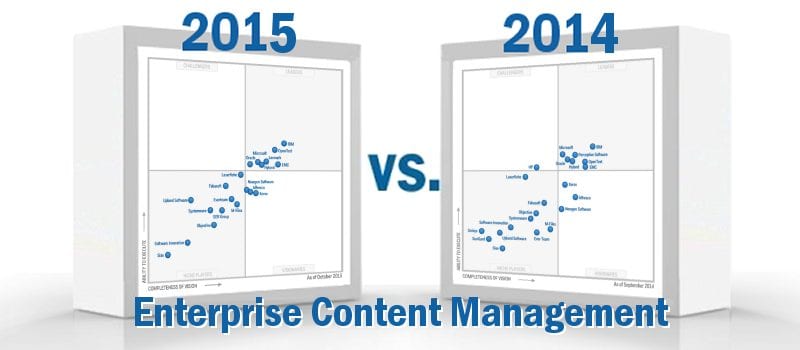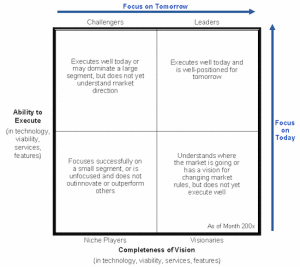What’s Changed: Gartner’s 2015 Enterprise Content Management Magic Quadrant


ECM is gaining momentum as a data solution that can help enterprises take control of their content. Analyst house Gartner, Inc. has released the latest iteration of its annual Magic Quadrant for Enterprise Content Management (MQ) report. This 2015 Magic Quadrant for Enterprise Content Management( ECM) was published in October 2015.
The ECM category is subject to a rapidly changing landscape, and Gartner recognizes that these shifts in the market will affect clients strongly- and not just regarding their MQ positioning.
“Consolidation in the market continues, with ever more tools that once belonged in the realm of specialist vendors now being part of the large ECM suites. These include enterprise file synchronization and sharing (EFSS), video content management and asset management. The ECM vendors build out these functionalities or acquire them through partnerships or direct acquisition of the technologies.” These acquisition of tools and tech are what play a major role in this year’s MQ, ‘Heave, Ho!’, as Gartner raised most vendor scores in ability to execute, topped off witha slight push to the right: advancement in completeness of vision.
If you’re unfamiliar with the MQ, Gartner evaluates the strengths and weaknesses of 20 vendors in 2015- that’s a slight drop from the 22 vendors featured in MQ 2014.These vendors are considered most significant in the market, and Gartner provides a graph (the Magic Quadrant) to plot the vendors based on their ability to execute a product or service, sales and/or pricing, etc and by a vendor’s completeness of vision. That graph is divided into four quadrants: Niche Players, Challengers, Visionaries, and Leaders.
This is the twelfth iteration of the ECM Magic Quadrant report, and as you might expect, there have been massive changes in the ever-evolving ECM market since Gartner’s first MQ report, in 2004. In the last year alone we’ve seen considerable shifts in positions on the MQ. At Solutions Review, We read the 38 page report, and pulled a few of what we consider the most important takeaways and key changes from the 2014 ECM Magic Quadrant.
What is Enterprise Content Management?
According to Gartner, the term “enterprise content management” (ECM) describes both a strategic framework and a technical architecture that supports all types of content (and format) throughout the content life cycle. As a strategic framework, ECM can help enterprises take control of their content.
“It can contribute to initiatives around transactional processes, compliance and records management as well as sharing and collaborating around content and documents. As a technical architecture, ECM can be delivered either as a suite of products integrated at the content or interface level or as a number of separate products that share a common architecture.”
I’ts no wonder that this year, research firm MarketandMarkets reported that the Enterprise Content Management market is expected to see revenue grow from $28.10 billion in 2016, to $66.27 billion by 2021.
How has the market changed? Ability to Execute
Ability to Execute measures how well a vendor is able to sell and support its ECM products and services. The vendors are also rated on their financial viability, which is done by a standard Gartner methodology that does not equate size with financial stability. Feedback on the current installed base, customer support, customer satisfaction and information about migrations is also taken into consideration.
“Next to the main core components, vendors can receive additional recognition for extended components such as search and analytics, which remain a critical aspect of content management as well other functionalities — including digital asset management, output management and archiving solutions, and email integration and management.”
Content management investments, while having a natural ebb and flow, continue to expand. This year saw an increased ability to execute with the exception of two vendors, across the board. According to Gartner, content management marketplace drivers focus on several key capabilities, including the ability to manage content throughout the full life cycle, providing information on demand, integrating and sharing content across packaged application systems, and by an enhanced collaborative work/content authoring and sharing through support of social software. As vendors work to enhance these capabilities they are able to offer more intelligent, fast, and homogeneous software to consumers who are looking for a content solution. These capabilities are the thing of an MQ leader.
Quadrants
Niche Players
In 2015, Niche players across this quadrant say the most significant raise in ability to execute, except for vendors, Siav, and Software Innovation. Among the ten vendors included, M-Files and Laserfiche gained traction in completeness of vision earning a spot within the quadrant for offering a complete package of hybrid cloud capabilities. M-files growth according to Gartner, is attributed to use of a “highly scalable and effective metadata-driven architecture, which allows for great flexibility in the use of metadata, including, for example, dynamic viewing of content.” However, Gartner acknowledges that M-Files is does not offer robust social content management capabilities, and that ECM organizations should consider this a vital capability in their product offerings.
Niche players are plentiful in this year’s quadrant described as, “Companies that focus successfully on a small segment, or are unfocused and do not out-innovate or outperform others.”
Visionaries
Gartner’s guide describes Visionaries: “They understand where the market is going or have a vision for changing market rules, but do not yet execute well.” Visionaries are typically smaller companies but have a very good awareness of how the market will evolve. Gartner uses “market understanding” as one of the evaluation criteria in positioning a ECM vendor’s completeness of vision, along with offering product strategy, and innovation. Of the three vendors selected of this category, NewGen Software, based in based in New Delhi, India is noted for customer support, and earned high scores for both pre-sales and postsales support; some of the highest scores of all the vendors included in the visionaries Q, all which remain the same since 2014.
Challengers
Challengers are characterized as, providers developing products that address the foundation needs of the corporate market which also boast strong sales, and visibility. There are no vendors in this category in 2015, as last year’s sole challenger, Hewlett Packard was not included in this years ECM MQ. HPE Content Manager, formerly Records Manager, continues to help business manage content by focusing on areas of automatic classification and policy application with linked security control, synchronization of policy with changing legal mandates, manage-in-place functionality, and feature rich mobile access. HPE Content Manager will helps businesses address cost, compliance, productivity and information privacy and security.
Leaders
To Gartner, leaders are defined as ECM software providers that, “Are perceived in the industry as thought leaders, and have well-articulated plans for enhancing recovery capabilities, improving ease of deployment and administration, and increasing their scalability and product breadth.” Wouldn’t you know, the leader quadrant is saturated with vendors that fit the bill. The most notable change from this year’s leader’s Q from last, is the change in identification of Perceptive Software, a division of Lexmark, to simply ” Lexmark”. In March 2015, Lexmark announced an agreement to acquire Kofax Limited for approximately $1 billion. Together, Kofax and Perceptive constitute a Lexmark Enterprise Software unit.
Market Overview
Gartner reports that the ECM market grew 6.2% in 2014 to a worldwide revenue of $5.4 billion, attributing first-time implementations, mobility-based upgrades and composite content applications (CCAs) as drivers of the continuous double-digit growth during 2014. Gartner explains the advancing technology has helped vendors aside from just leaders, share a piece of the pie.
“Product specialization — aligned to country-based business requirements — increased the fragmentation of market share as best-of-breed and regional vendors succeeded in out-competing their larger international rivals. The combined market share of the top three ECM vendors continued to decline — from approximately 46% in 2012, to 44% in 2013, and to 41% in 2014.”
For more about Gartner’s news and reports, follow us on Twitter, and Linkedin and stay current on the most up-to-date news and trends in Backup and Disaster Recovery.
For more Content Management solutions providers outside of Gartner’s MQ





















